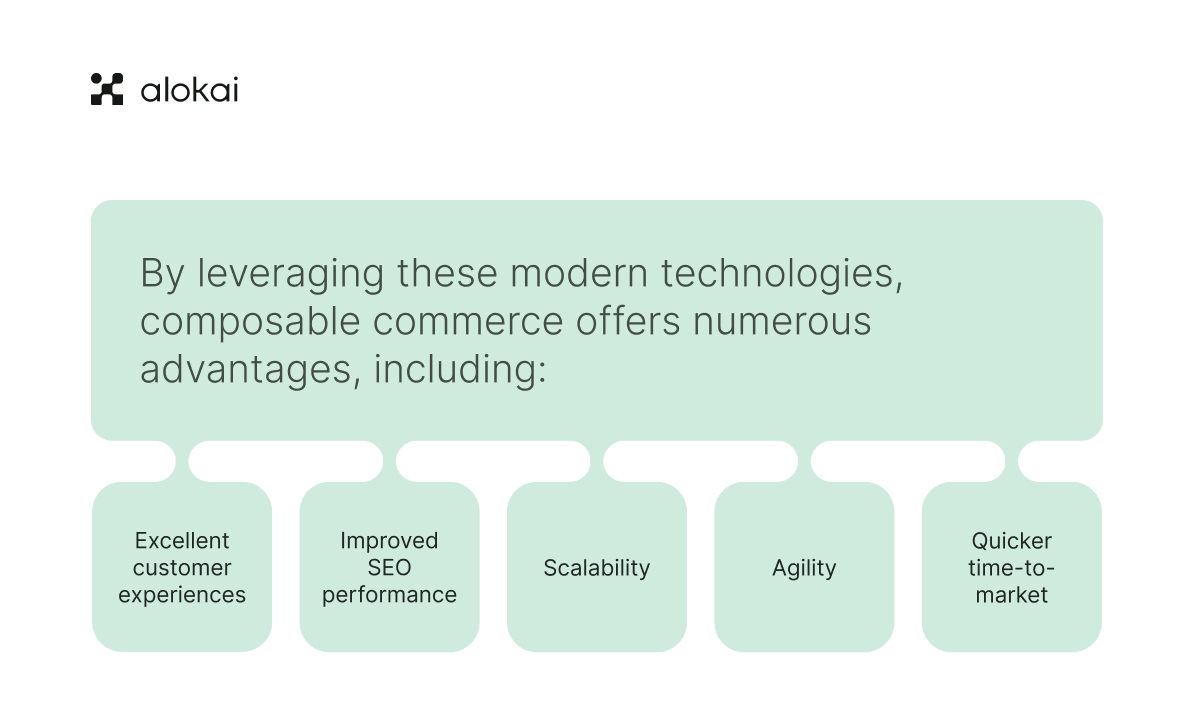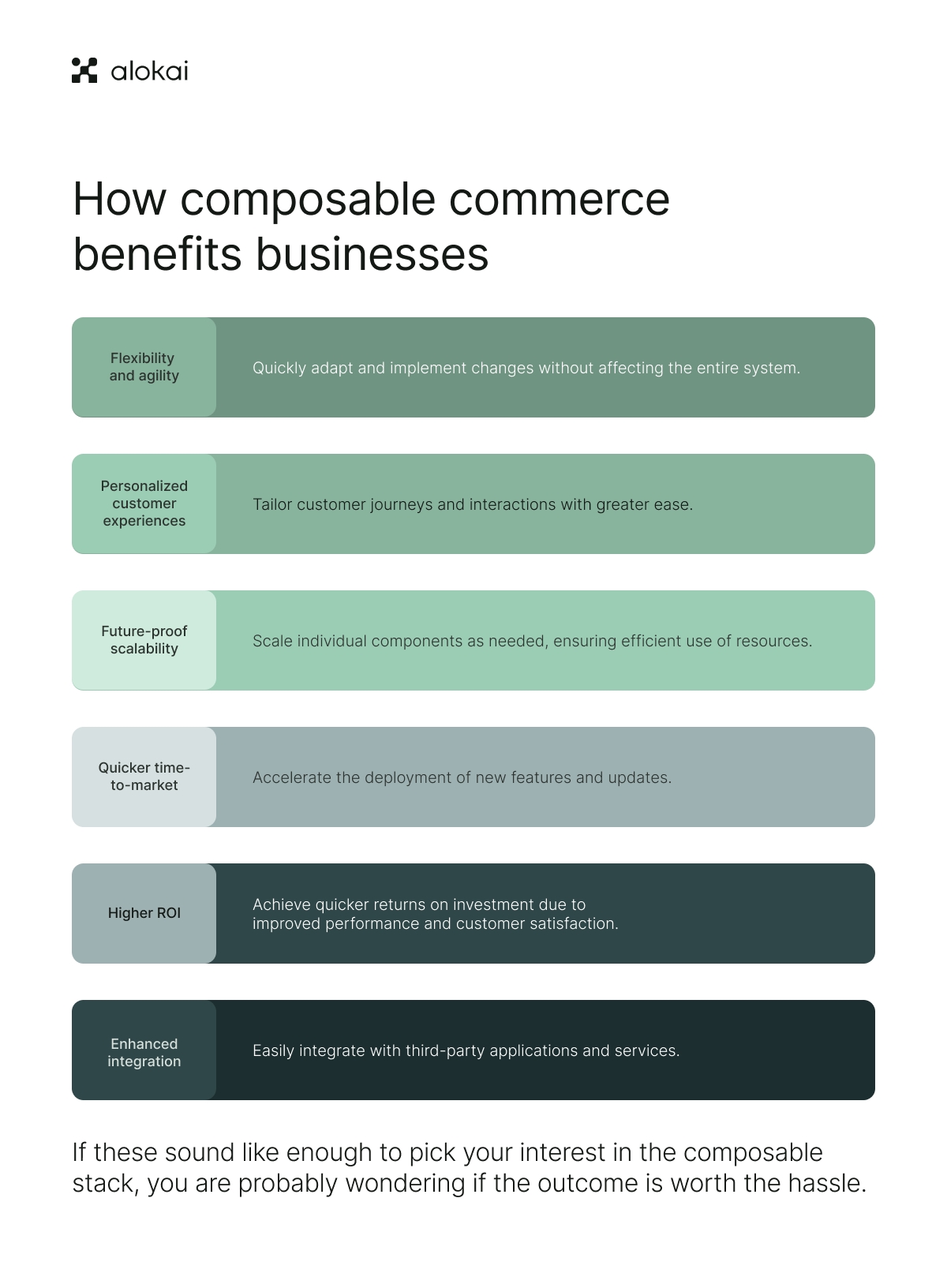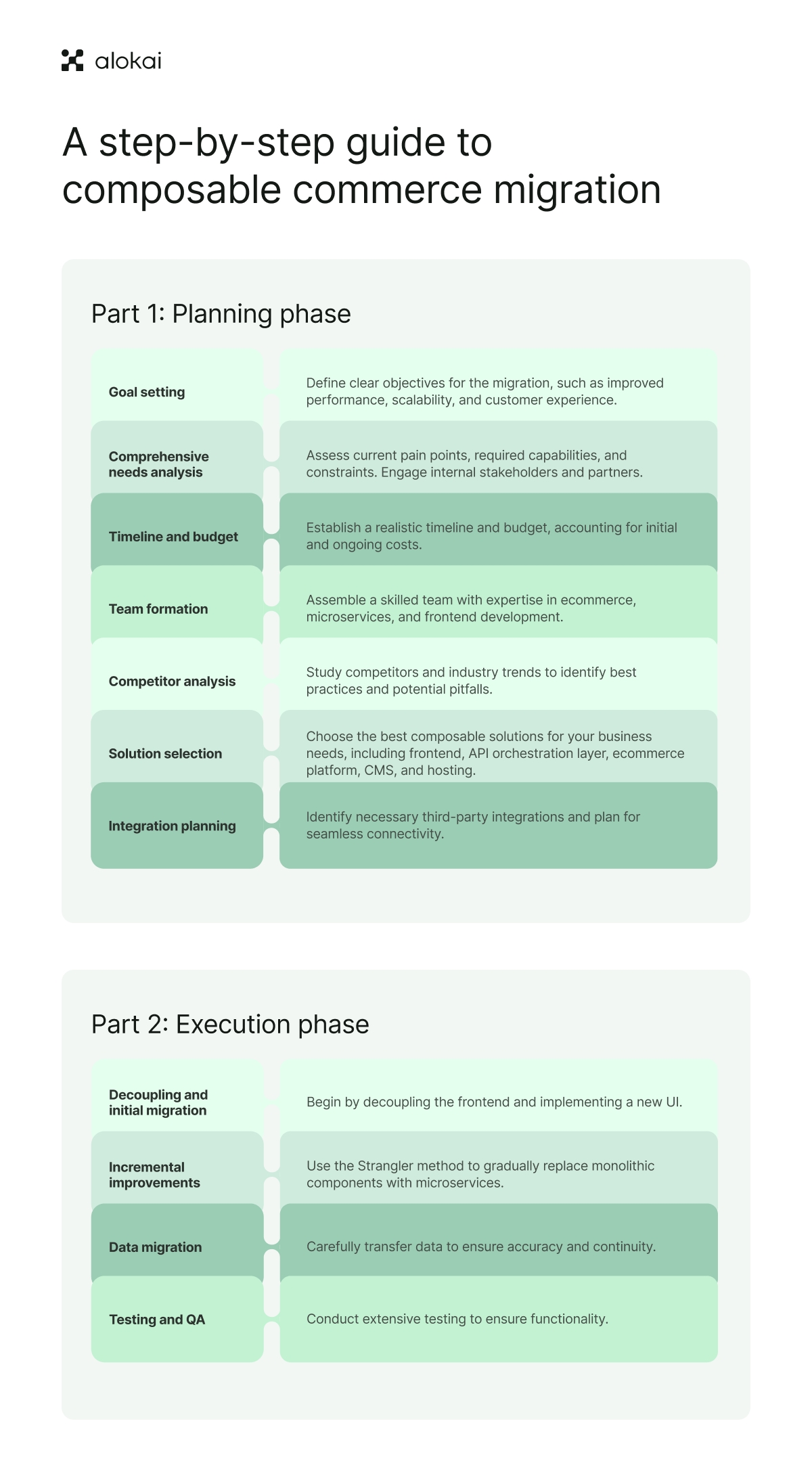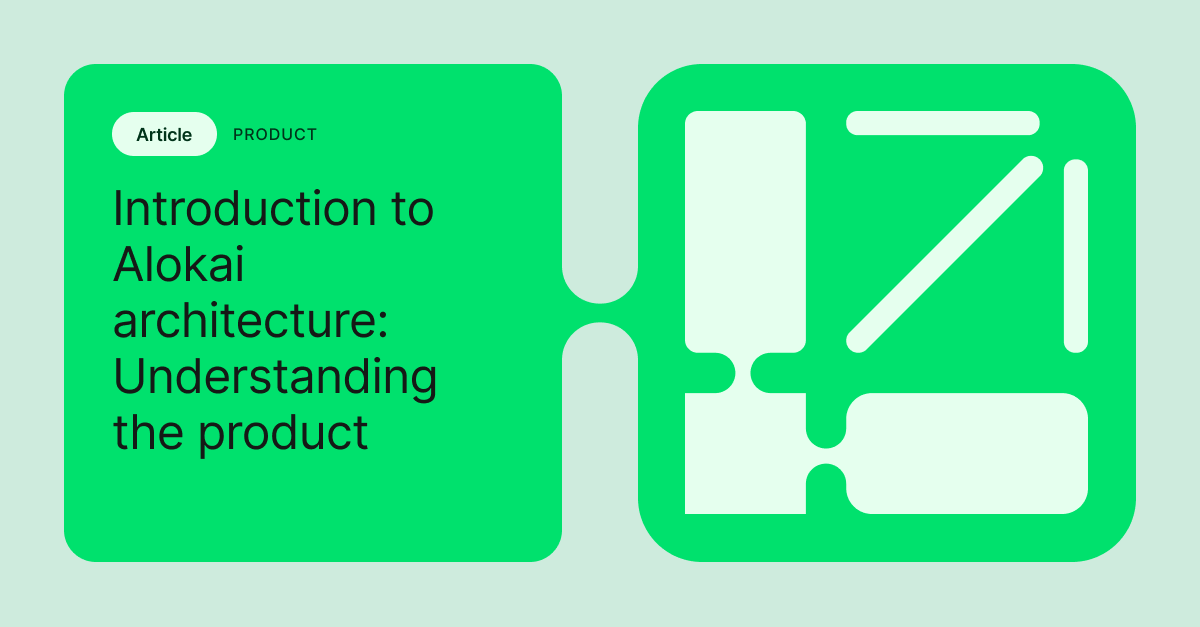Global retail ecommerce sales are estimated to reach $6.3tn in 2024. With online shopping booming, another trend is gathering pace: the rise of composable commerce.
Ecommerce businesses are increasingly turning to composable commerce architectures. The shift from legacy monolithic systems to composable stack is driven in part by the need for greater flexibility, personalized experiences, and the ability to thrive in the competitive modern commerce world.
For businesses looking to make the shift to composability, it’s important to consider the migration steps. In this article, we provide a comprehensive roadmap for migrating to composable commerce or headless commerce stack, detailing different approaches, key considerations, benefits, challenges, and best practices for a successful transition.
What does composable commerce mean?
Composable commerce is an architectural approach where the frontend interface (UI/presentation layer) is decoupled from the backend system (ecommerce platform, CMS, and other components).
Composable commerce architecture means that businesses can construct their tech stack using various best–of-breed microservices applications tailored to their specific needs – while still being able to keep their ecommerce platform or backend system. Undoubtedly, this is one of the countless advantages of making the move to composable commerce.
It gives you the ability to quickly make changes to the interface without impacting the underlying infrastructure, and updating features on any one of the composable elements is done swiftly and independently.
It also makes it easier to integrate with third-party applications and services. As a result, businesses that adopt a composable commerce approach are able to be more agile and responsive to changing customer needs.
Key building blocks of a composable commerce tech stack include:
Frontend framework: The presentation layer that delivers the user interface (Storefront UI) and user experience (UX). This is the initial component of the architecture that will position your ecommerce platform's user interface in front of consumers to provide them with the most favorable digital user experience.
API orchestration layer: The API layer acts as the access point for all the building blocks, enabling communication between components.
Ecommerce platform: The core system managing product data, transactions, and other essential ecommerce functionalities. Modern solutions include BigCommerce, commercetools, Elastic Path, and other well-known software.
CMS: This manages and organizes website content and products.
Hosting: The infrastructure to deploy and maintain the website and its components.
Advantages of going composable
Composable commerce is built with modern technologies like PWA (progressive web apps), microservices, and PBCs (packaged business capabilities), which all communicate via APIs.
8 business reasons to go composable.

But what is the alternative?
Understanding monolithic systems
To better understand the benefits of migrating to composable commerce, it’s important to understand some of the limitations of monolithic systems.
These systems are legacy architectures where the frontend and backend are tightly coupled into a single, unified codebase. While this approach was once standard, it presents several drawbacks:
Inflexibility: Changes to one part of the system often require changes to the entire system, leading to longer development cycles and a drain on resources.
Scalability issues: Scaling specific components independently is challenging, often resulting in over-provisioning.
Maintenance challenges: Debugging and updating a monolithic system is complex and time-consuming, especially as the codebase grows and evolves.
Limited customization: Customizing features to meet specific business needs can be cumbersome and restricted.
Monolithic systems are notoriously sluggish, making it difficult for businesses to adapt to changes the market demands or integrate new technologies. The tightly-coupled nature means even minor adjustments require considerable time and resources to implement.
Why brands and retailers are migrating to composable commerce
Traditional commerce platforms therefore have several limitations. They block the rapid innovations necessary for meeting the evolving expectations of today’s consumers.
On the other hand, composable commerce delivers unprecedented flexibility, scalability, and customization to keep pace with the changing retail world.
How composable commerce benefits businesses

Flexibility and agility: Quickly adapt and implement changes without affecting the entire system.
Personalized customer experiences: Tailor customer journeys and interactions with greater ease.
Future-proof scalability: Scale individual components as needed, ensuring efficient use of resources.
Quicker time-to-market: Accelerate the deployment of new features and updates.
Higher ROI: Achieve quicker returns on investment due to improved performance and customer satisfaction.
Enhanced integration: Easily integrate with third-party applications and services.
If these sound like enough to pick your interest in the composable stack, you are probably wondering if the outcome is worth the hassle.
Migrating vs. replatforming from monolith to composable
When it comes to making the move to composable commerce, there are generally two main approaches: migration and replatforming.

Migrating to composable commerce
Migrating involves a phased approach where businesses gradually upgrade their ecommerce store while continuing to use their existing ecommerce platform. This approach can be executed using strategies like the Strangler method, where individual components are incrementally replaced and improved.
Key steps with this approach include:
Decoupling the frontend: Separating the frontend UI from the backend platform.
Replacing the legacy storefront: Implementing a modern frontend for composable commerce.
Gradual improvements: Enhancing features and functionalities in an incremental fashion.
This is the approach we vouch for in Alokai – schedule a personalized demo to see if it’s a good fit for your business!
Replatforming: building a new tech stack
Replatforming entails building a completely new composable tech stack separate from the current system.
This approach involves:
Creating a new composable stack: Developing a new architecture with PWAs, microservices, and PBCs.
Data migration and testing: Transferring data to the new system and conducting thorough testing.
Complete transition: Switching over to the new composable solution once it’s fully functional.
Both strategies have their merits, and you can choose the best option for your specific needs and constraints. A phased migration is often less disruptive and allows for a smoother transition while replatforming can offer a fresh start with modern capabilities.
Challenges of moving to composable commerce
Like all important changes in business strategy, transitioning to composable commerce offers many benefits but there are some associated risks and misconceptions you need to be aware of, such as:
Complexity: Managing multiple independent services and ensuring seamless integration is not a piece of cake.
Costs: Initial development and ongoing maintenance can be higher than legacy systems due to the need to develop both the frontend and backend separately.
Data migration: Ensuring data integrity and minimal disruption during the transition requires upmost care and security in place.
Team expertise: Skilled developers familiar with modern technologies and microservices architecture are required for successfully completing the project.
Misconceptions: It is easy to underestimate the scope and resources needed for migration or fall under the impression that you must replatform in order to benefit from composable commerce.
Facilitate your migration to composable with Alokai
Thanks to frontend as a service (FEaaS) platforms like Alokai, many of these challenges can be offset.
Alokai is an out-of-the-box frontend for composable commerce, offering an all-in-one solution that includes your storefront UI and API orchestration layer. It also has an array of ready integrations (PBCs) with all the most prominent ecommerce platforms like commercetools, BigCommerce, Elastic Path, and CMSs. By using a code-ready frontend for composable commerce, you can save significant time and costs.
Best practices for composable commerce migration
Adopting a new composable architecture comes with a number of considerations to ensure a smooth transition. Here’s what you need to think about in order to simplify the migration process.
Comprehensive needs analysis
Before initiating discussions with potential vendors, you should always invest in conducting a thorough needs analysis. This process helps map out the migration or replatform journey and ensures alignment with business goals and requirements.
As you begin your composable commerce migration or replatforming journey, consider the following:
The reason for migrating or replatforming, and the timeline for relaunching your system.
Understanding the primary reason for migrating or replatforming is crucial. Create a detailed list of current pain points, such as poor conversion rates, customer dissatisfaction, wasted resources, outages, and high overhead costs. In addition, established a desired timeline for relaunch.Your primary goals.
Identify and rank your main goals. These might be: reducing total cost of ownership (TCO), increasing revenue through a modern tech stack, or improving efficiency by unburdening IT. Ensure these goals align with why consumers choose your products or services to avoid misalignment or wasted efforts.Maintaining scalability during peak trading times.
Consider how you plan for your store’s performance during peak seasons. For example, how do you predict traffic, forecast sales, or manage high volumes of simultaneous checkouts.Integrations.
List the third-party tools, in-house software, and partners that are essential for your operations. Consider potential integrations such as proprietary software, marketing tools, CRM, payment gateways, inventory management, ERP systems, and analytics tools.Sales channels.
Document your sales channels, including online communities, customer service representatives, marketplaces, POS systems, and social networks. Outline your strategy for wholesale and B2B ecommerce if applicable.Your approach to global ecommerce.
Identify the nations, currencies, and languages you operate in and describe how you target and customize your messaging based on geography. If you don’t have an international ecommerce strategy, note if this may be relevant as a future objective.Implementing content, design, product, and UX changes.
Detail your company’s operating procedures, including team composition, implementation speed, and team size, for making changes to content, design, products, and user experiences.Unique customizations or product configurations.
Highlight unique features vital to your business, such as pricing structures, upsells, product rules, bundles, recurring shipments, and custom onsite search.Operating costs.
Thoroughly document initial and ongoing costs, including design and development, servers, maintenance fees, hosting, licensing, security, and content delivery network (CDN) expenses. This will help determine the TCO.Competitors and brands you follow.
Create a shortlist of competitors and brands you admire, noting critical aspects of their online or offline presence that you appreciate.Other areas you should consider are the user experience and SEO.
Maintaining organic visibility built over years of SEO efforts is a common concern during migration or replatforming. Composable commerce allows for agile, iterative development, improving SEO by making content creation and management easier. Ensure a balance between UX and SEO by having both teams collaborate closely to achieve the best results.The other key consideration is associated costs.
Development, hosting, and maintenance costs may be higher due to the separation of the frontend and the backend.
Migration to composable commerce: The Strangler approach
Migrating critical components of your legacy system is an effective way to start, especially if your goal is to improve customer experience and performance quickly. Begin with the frontend (UI) to immediately enhance SEO, customer experience, and user experience. Continue using your existing ecommerce platform while optimizing the UI and integrating composable CMSs and other third-party tools.
The Strangler approach allows for incremental replatforming by developing a new application on top of the existing system. This method involves building microservices that provide both existing and new functionalities, gradually replacing the old monolithic application.
Key benefits of the Strangler approach include:
Minimized risks: Allows for a gradual transition to the new architecture.
Cost efficiency: Avoids the need for a complete rewrite, which can be expensive and time-consuming.
Incremental improvements: Enhances the overall system design step by step.
Easier data migration: Facilitates the smooth transfer of data and users to the new system.
For a successful migration using the Strangler approach, it's crucial to understand your current architecture and plan your migration strategy carefully. Assemble a skilled team and move services at your own pace, ensuring continuous functionality and performance.

Replatforming to a composable commerce stack
When moving from a monolithic ecommerce platform to a complete composable stack in one go, several key considerations and steps must be taken into account to ensure a smooth transition.
Steps for replatforming to composable commerce:
1. Define your goals via discovery and gap analysis
Before anything else, define your objectives for replatforming to a composable architecture. Identify the pain points and functionalities needed, saving time and effort later.
Conduct a comprehensive needs analysis to investigate and choose the best composable solutions for your business. Understand your current ecommerce situation and develop a vision for the future, analyzing your users, order flow, products, and integration needs.
2. Analyze costs and build a business case
Replatforming involves costs beyond the migration budget, including verifying new API functionality and ongoing operating expenses. Build a compelling business case, demonstrating how the new platform will improve inventory management, add SKUs, and boost SEO, justifying the switch even if expenses are higher.
3. Set priorities based on your requirements
Start with the frontend (UI) when replatforming, as it is the most visible part of your stack. The UI must collaborate effectively with other elements to present your brand and business messaging to customers.
4. Map your replatforming path and scenarios
Ensure your website does not need to go offline during replatforming by planning and implementing the process well. Consult with a professional ecommerce software consultant to minimize business disruption.
5. Issue a Request For Proposal (RFP)
Send RFPs to potential platforms to establish your company’s objectives and requirements formally. This allows you to evaluate and assess prospective solutions on your terms.
6. Choose the right storefront, ecommerce platform, and CMS
Select a composable commerce solution that meets your business needs. Consider your objectives and the specific functionalities required before making a decision.
7. Migrate your data to the new system
Determine which data migration service to use and plan the migration schedule. Ensure data accuracy and continuity during the transfer process.
8. Connect your frontend with the new backend
Pair integrations, extensions, and plugins via APIs. Redesign the site, relaunch in beta, and conduct quality assurance (QA) with stakeholders. This will provide a fast, reliable, and decoupled frontend that can be easily updated and maintained.
9. Test
Conduct thorough testing before going live to ensure functionality, performance, and user experience are as expected. This helps prevent interruptions and breakdowns during the transition.
10. Relaunch the site publicly and redirect URLs
Once testing is complete, relaunch the site and redirect URLs to ensure a smooth transition and maintain SEO rankings.
With these steps and best practices in mind, your journey to composable commerce is sure to be a success.
The role of Alokai in composable commerce migration: Custom build frontends vs. out-of-the-box frontends
One of the significant barriers to replatforming or migrating from monolithic systems to modern composable commerce is the belief that your only choice is to custom-build a frontend for your new composable stack. Fortunately, this is not the case anymore: You don’t have to build your frontend from scratch.
Custom builds offer high flexibility but are resource-intensive and time-consuming. In contrast, out-of-the-box (OOTB) solutions like Alokai provide a balanced approach with pre-built components and integrations.
There are many benefits of buying an OOTB frontend platform for your ecommerce business. Perhaps the most obvious benefit is that it can save you time and money. Building an ecommerce website from scratch can be very costly and time-consuming.
Benefits of OOTB solutions like Alokai:
Reduced development time: Save up to 5,000 development hours with ready architecture and components. This significantly shortens the time-to-market for new features, enabling quick deployment and updates in days, not months.
Cost efficiency: Lower total cost of ownership by minimizing custom development needs. Alokai provides a comprehensive solution that reduces the need for extensive in-house development, resulting in significant cost savings.
Seamless integrations: Pre-coded PBCs and API integrations with leading ecommerce platforms and third-party services ensure seamless connectivity and functionality. This allows for the integration of best-of-breed solutions tailored to your specific business needs.
Enhanced performance: Built-in optimizations for web performance, including Server-Side Rendering (SSR), lazy loading, and semantic HTML, contribute to exceptional web performance. Modern JavaScript frameworks enhance performance, providing a superior user experience.
Customizability: Retain control over the look, feel, and functionality of your storefront. Alokai allows for extensive customization, ensuring that the customer experience and journey align with your brand identity and business goals.
Scalability: Easily scale components as needed to handle growth and peak loads. Continuous iteration and innovation ensure the system is future-proofed against scalability issues.
Excellent omnichannel capabilities: The backend layer is decoupled from the presentation layer, enabling personalized content delivery across multiple touchpoints. This ensures consistent and tailored customer experiences on every channel.
Future-proofing: Stay updated with the latest technologies and trends without extensive rework. The API-first architecture allows merchants to adapt their ecommerce system to evolving market demands and technological advancements.
Improved customer experiences: Offers, discounts, and recommendations tailored to customer demands encourage purchases. This personalized approach enhances customer satisfaction and loyalty.
Flexibility of a start-up: Adding new features or testing new services can be done with minimal risk of disrupting the entire system. Developers can work independently, focusing on their specific tasks without waiting for other teams, fostering innovation and agility.
Unlimited UX/UI control: Decoupled units simplify frontend operations without impacting the backend. This enables merchants to concentrate on marketing strategies and enhancing user experience, ultimately leading to better customer satisfaction and engagement.
Lower IT expenses: Developer teams can operate independently, reducing the risk of system-wide disruptions. This independence allows more time for experimentation and development, leading to more efficient use of resources and lower IT costs overall.
With a modern frontend for composable commerce like Alokai, you retain complete control over your store's look, feel, and functionality, much like a custom build. This ensures that the customer experience is highly customizable and aligned with your business objectives.
The path forward with composable commerce
Migrating to composable commerce represents a significant step forward for ecommerce businesses, offering unparalleled flexibility, agility, and scalability. By following best practices and carefully planning the migration, you can overcome challenges and achieve a seamless and successful transition.
Whether opting for a phased migration or complete replatforming, the benefits of composable commerce — improved customer experiences, faster time-to-market, and enhanced integration capabilities — make it a worthwhile investment. Platforms like Alokai provide valuable solutions to streamline the process, making composable commerce more accessible and effective for businesses of all sizes.













